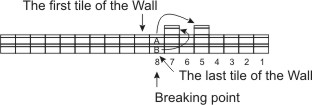The complete game of Mah Jong ordinarily consists of 16 hands (or deals), though the number may be increased each time the dealer (East) wins, or when a deal ends in a draw. Each hand begins with the building of the Wall, breaking it, and dealing the tiles.
Before the game starts players throw the dice several times in order to determine the seat order, the first dealer (East) and to determine the place where the Wall is to be broken.
To start the game each player throws two dice, the highest becoming the first East, the second highest becoming South, third highest West and fourth highest North.
The players retain their relative positions (though not their seat designations, as the winds rotate) until the game has been completed.
Before each hand all the tiles are placed face down on the table and thoroughly mixed by non-dealers, until East gives the command 'Pow' (meaning 'start'), after which each of the four players picks up 36 tiles and builds a row of tiles in front of him, 18 tiles long and 2 high (when 8 jokers are used, each player picks up 38 tiles and builds a row 19 tiles long; when 4 jokers are used, only East and West build a longer row). Each player then pushes his row forward to form a hollow square. This formation is called Wall.
To determine the breaking point of the Wall, the dealer (East) throws the two dice and counts counterclockwise round the walls, beginning with himself as one (accordingly, numbers 5 and 9 indicate East, numbers 2, 6 and 10 South, numbers 3, 7 and 11 West and numbers 4, 8 and 12 North). The player thus indicated then counts off to the number thrown by East, along the tiles of the top tier of his wall (a stack of two tiles at a time), starting from the right end.
He makes a break in the wall by removing the stack of two tiles indicated by the number thrown, and placing these tiles (also known as 'loose tiles') on top of the wall to the right of the breaking point, the uppermost tile being placed further from the breaking point. Normally the uppermost tile is placed on top of the third stack to the right of the breaking point, and the lowermost on top of the first stack.
The tail end of the Wall – along with the two loose tiles – is known as Dead Wall (or Kong box, or Garden Wall), while the tiles to the left of the breaking point constitute the live Wall. Actually the American rules do not use Dead Wall at all, since all tiles are available for play and replacement tiles for Kongs and Flowers and Seasons are simply taken from the tail end of the Wall. (In classical rules Dead Wall is either exhaustible, consisting of a fixed number of tiles reserved as supplement tiles; or replenishing, meaning that the Dead Wall is always replenished from the live Wall to always consist of a fixed number of tiles not available for other purposes.)
When supplement tiles are needed normally the player on whose side the tail end of the Wall resides is responsible of giving them. The rightmost "loose" tile is always used first, and when both "loose" tiles are used, two new "loose tiles" from the tail end of the Wall are lifted (the uppermost tile once again being placed to the right of the lowermost tile).
East starts the deal by taking the first two stacks of the tiles (i.e., four tiles) from the left of the break, then each of the other three players pick two stacks of tiles in order South, West and North. This is repeated twice so that each player has 12 tiles. East then draws the 1st and 5th tile from the open end of the Wall (as displayed in Fig. 1-d below), and South, East and North in turn take one tile each. Thus the dealer has 14 tiles and the other three players each 13 tiles.
The hand starts by each player arranging the dealt tiles so that their faces are not visible to the opponents, but in such a way that the other players may count them.
If the dealt hand contains Flowers or Seasons, they are immediately melded (placed face up above and to the side of the hand) and replaced with regular tiles taken from the tail end of the Wall (East replaces first his extra tiles, then South, West and North). Should a player draw further bonus tiles during this replacement procedure, he immediately takes supplement tiles for these, as well.
Figure 1. Building and breaking the Wall.
|
|

b) East throws the two dice – eight, in this case – and counts counterclockwise round the walls. |

c) The player thus indicated (North in this case) counts off to the number thrown by East (8 in this case), along the tiles of the top tier of his wall, starting from the right end, breaks the wall by placing the two loose tiles (A and B) on top of the Wall to the right of the breaking point. The supplement tiles for Kongs and Flowers and Seasons are taken from the right of the breaking point while the deal is started from the left of the breaking point. |
|
d) The players take each 2 stacks of tiles (i.e., four tiles at a time) from the start of the live Wall, in order East, South, West and North, until each player has 12 tiles. East picks his 13th and 14th tile as illustrated in picture above (note that these two tiles are picked at the same time and South, West and North pick their final tiles only after this). This is called chan-chan because of the sound made by the clicking of the two tiles (see picture). |
|
Related topics:
Introduction
Tiles
Playing
Miscellaneous
Scoring
Payments